M4U4 body language reading 学案
人教版高中英语必修4《Unit4Bodylanguage》教案

人教版高中英语必修4《Unit4Bodylanguage》教案人教版高中英语必修4《Unit 4 Body language》教案【一】教学准备教学目标1. 教学目标(1)知识目标:学生能掌握下列重点单词和短语的意义和用法:greet, represent, approach, expression, defend, misunderstand, adult, cheek, major, likely, in general。
能够表达一些Body language.(2)能力目标:学生能掌握基本的阅读理解方法:速读,寻读,归纳中心和查找细节。
(3)情感目标:学生了解不同国家和文化的身势语,激发学生学习这种语言的兴趣。
教学重难点教学重点和难点(1) 培养学生的阅读策略和技巧,让学生了解文章的细节知识和文章结构。
(2) 让学生合适地使用不同的身势语。
(3)课文中现在分词作定语和状语的长难句。
教学过程Step 1. Lead in(1)The teacher shows a question on screen:How can we communicate with others when we can’t speak ?Then ask a student to answer.设计说明:引出本单元的话题。
(2) The teacher shows some pictures on screen of some body language and ask some students to guess and discuss the meaning they stand for. 设计说明:引出本节课的题目。
Step 2. Fast reading1. Go through the passage quickly and find out the main idea of each paragraph.o Match the main idea of each para. with lines.(Para.1) A. Other examples of different greeting body language.(Para.2) B. Different people have different body language.(Para.3) C. Summary of body language.(Para.4) D. Meet the visitors at the airport.(Para.5) E. Examples of different greeting body language.2. Try to write down the main idea of the text.The text is mainly about different _____________ in different countries. In order to avoid difficulties in today’s world of cultural crossroads, we should ___________________________.设计说明:通过这个题目的练习,让学生掌握速读,先对文章段落大意有一个了解。
高中英语人教新课标必修四Unit-4Body-language教(学)案

Unit 4 Body language阅读课一、教学容Pre-reading (p.25); Reading (p.26); Comprehending (p.27)二、教学目标1. 能力目标●让学生通过阅读,能够理解并尊重不同区域的人的身体语言和其文化涵义。
●进一步训练学生推测、略读、找读、归纳容等阅读技巧;培养学生把握篇章中心容、归纳段落大意、获取关键信息、并且能针对阅读容表达自己的观点的能力。
2. 语言目标●重点词汇与短语greet prediction represent association dormitory canteen flight curiouscuriouly Colombia approach cheek defend defence majormisunderstanding Jordan dash adult spoken Spain Italy likely crossroadsdefend against be likely to in general●重点句子结构与用法Yesterday, another student and I, representing our university’s student association, wentto …After half an hour of waiting for their flight to arrive, I saw several young people enterthe waiting area looking around curiously.I stood for a minute watching them and then went to greet them.She stepped back appearing surprised and put up her hands, as if in defence.Then Akira Nagata from Japan came in smiling, together with Japanese student.When Darlene Coulon from France came dashing through the door, she recognizedTony Garcia’s smiling face.三、教学步骤步骤一读前1. 引导学生回顾Warming Up局部和听力材料的容,布置学生各组不同的任务归纳人和黑猩猩的相似之处。
人教版高中英语必修四第4单元《body language-reading》教案

Unit4 Body Language金溪一中王萍丽课题Period 1 Warming up and Reading教学目标知识目标Get the students to learn some useful new words and expression.能力目标Develop the students’ reading ability ..情感目标Get the students to know how to greet each other in different cultures.教学重点Get the students to know basic knowledge about body language. 教学难点Develop the student s’ reading ability.教学过程Step1 Lead-inSignal to a student to close the door and ask the student the question:How do you know what I want you to do?Step2 Warming up1.What is body language?One form of communication without using any words2.Performing & GuessingStep3 Pre-reading DiscussionThere are many different ways to greet someone using words. How many ways can you think of to greet someone if you CANNOT speak? Share your ideas with your partner.Ways to greet someone without words: smile, wave, shake hands, hug, kiss, etc. Step4 Reading1.SkimmingWhat is the main idea of the text?A. There are different customs in different countries.B. Foreigners should follow the customs of the country where they are visiting.C. People use body language to send messages and people from different countries have different customs.D. The importance of knowing customs.2.Scanning(1)How many international students are there in the story?(2)Who are they and where do they come from?.3.Careful ReadingPara1When: yesterdayWho: another student and I,this year’s international studentsWhere:the Capital International AirportWhat to do: We would take them first to their dormitories and then to the student canteen.Para2Find out the two cultural mistakes the author found at the airport:Para3:Answer the following questions1.How do men from Muslim countries greet others?2.How did Tony and Darlene greet each other?Para 5:Fill in the blanksThese actions are not good or bad, but are simply ways in which .In general, studying international customs can certainly help avoid difficulties in today’s world of cultural crossroads!Step 6 Giving PerformancePlease act out according to the following situations(choose either one):Situation 1: You are meeting a British friend in the airport, and you are going to hug him. Imagine what will happen.Situation 2: You are visiting in another country, and you want to cut hair, but you have difficulty in communicating. How can you communicate with the barber with body language?Step7 Homework:1.Recite the new words in the text.2.2. Go over “Learning about language”1. 2. And 3 on P27-28.。
人教版高中英语必修四 Unit 4 Body Language Reading教案 (1)
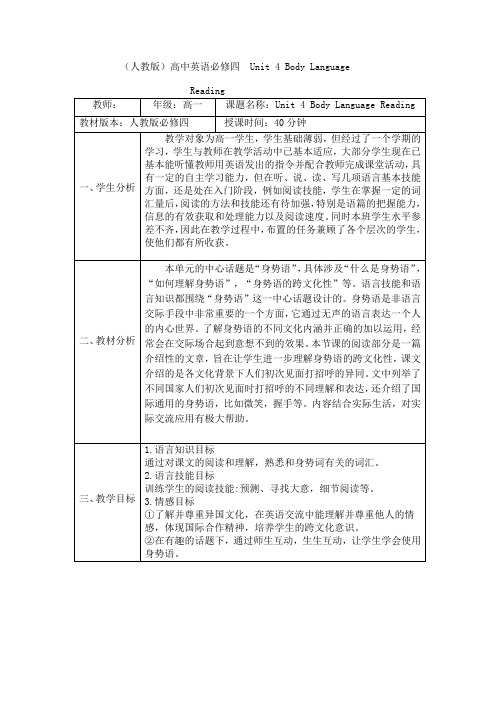
(人教版)高中英语必修四 Unit 4 Body Language四、教学策略1. 运用导学案的形式,培养学生自主阅读的习惯。
2.学生通过听、说、读、写这四种基本形式,完成对课文由浅入深的理解.3.通过速读和细读形式,训练学生对课文信息的获取和处理能力。
4.利用视频教学,让学生对身势语在不同文化背景下呈现出不同含意有一个更加生动的了解。
五、教学重点和难点重点: 如何提高学生的阅读理解能力,培养学生捕捉关键句和查读寻找信息的能力。
根据英语课程标准关于语言技能的教学建议,略读与细读是阅读教学的基本技能之一,是学生必须掌握的。
难点:如何通过小组合作,对课文信息进行摄取和取舍,运用所学语言知识,运用各种“身势语”来进行交流。
根据英语课程标准,文化意识是内容标准之一,要求学生掌握一些行为规范、风土人情等方面的知识,这有利于培养学生的世界意识,有利于形成跨文化交际能力。
六、教学步骤 Teaching proceduresSteps Teacher’s activities Students’ activities AimsStep 1:Lead ine body language toact: I win and I’m happyto lead in this class.2.Ask students to enjoysome pictures andconclude what’s bodylanguage.3. Ask students to play agame.4.Ask students to enjoya video about differentcountries use differentbody languages toexpress the samemeaning.1. Look at what theteacher acts and guessher meaning.2.Enjoy the picturesand act body language .3.Watch the video anddraw a conclusionBy showing somepictures,acting andplaying the flash toarise students’interest in bodylanguage.Steps 2:Reading Task1: Skimming 1.Ask students to predictthe main idea by lookingat the title and thepicture on page 26.2.Ask students to dividethe passage into fourparts and match the mainidea of each part.3.Ask students to findhow many characters arementioned in ourpassage and who arethey in the picture.1.Work in groups anddiscuss to choose theright main idea as soonas possible.2.Skim the passage andmatch the rightanswers, then readtogether.3.Find the characters.Practic e students’skimming skills tohave a generalunderstanding aboutthe passage.Steps 3:Reading Task2:Detailed reading 1.Ask students to readpara.1 together andfind the information ofwhen、who、where andwhat.2.Ask students to listento para. 2-3,fill the tableabout Nationality andBody Language thenplay a game.3.Ask students to listento part3 and part4 andchoose the rightanswers.1.Read together andfind the four “wh”2.Listen to the tape andfind details to finish thetable.3.Work in pairs to actdifferent countries havedifferent greetingways,then other groupsguess which country arethe actors from.4.Listen to part 3-4 andchoose the rightanswers.By giving differenttypes of questionswhich are arrangedfrom the shallower tothe deepen,on onehand,students have adeeper understandingof the passage,on theother hand,theypractice readingskills,spoken Englishand Listening.Step4:Summary1.Play a flash aboutbody language.2.According to theflash and the passage,summarize the wholeclass. 1.Enjoy the flash andreview what they havelearned today.2.With the help of theteacher, summarize thewhole class and readthe summary.Deepen students’understanding ofbody language in theworld and build uptheir internationalcommunication。
人教版英语必修四Unit 4 Body language教案(1)

高中英语模块四教学设计Unit 4 Body languageReading:Communication:no problem?教材:人教版《英语4[必修] New Senior English for China》一、教学对象分析本校为省普通高中达标校。
学生英语水平较为参差,且班级人数多。
二、教材内容分析本节课选自人教版高中英语必修4 Unit4 Body language,这节课课型是Reading。
因为是第四单元第一课时,它起着承上启下的作用。
三、教学目标主要教学目标有两个:1.成功导入单元中心话题“body language”2.阅读课文“Communication :no problem?”找出不同文化信息及两个文化差错。
四、教学过程Step 1 Warming-up and lead-in (5 mins)教师设计一些小活动和学生进行互动,了解学生对肢体语言一些基本情况的熟悉程度,以此导入到本课的课题。
活动1 利用四张图片进行师生对话,引入肢体语言表达方式:脸部表情,手势,动作等。
活动2 师生一起做TPR(Total Physical Response) 活动。
目的在于复习一些身体部位的表达方法,为接下去的活动做好准备。
活动3 推荐四组学生上台根据图片提示做动作,让全班同学猜出它们的意思,进行全班互动。
活跃课堂气氛的同时,传达肢体语言在生活中的作用。
Activity 1:The teacher shows some pictures on screen.T:What does these pictures mean?Ss:crying,laughing,it’s happy/…,they are excited (to celebrate their success.)T: Great!Activity 2:T: Now let’s do some TPR (Total Physical Response) activities together, I hope you will enjoy them and have fun as well.(the whole class together)Touch your head / face / eyes / nose / mouth / ears / cheeks / forehead / shoulders / stomach / legs / feet / toes ... (some students to come to perform)Shake your head / arm / hand ...Close your eyes / mouth ...Open your eyes / arms /mouth ...Nod your head.Some students to come to perform.1.Shake somebody’s hands.2.Touch the other’s shoulder.3. Cross your arms .4.Make a face to each other.5. Dance as you like .Step 2 Reading (20 mins)1.Warming-up利用教材SBP25 Warming-upEx.1所提供图片,两两对话。
m4 unit4 reading 学案2课时
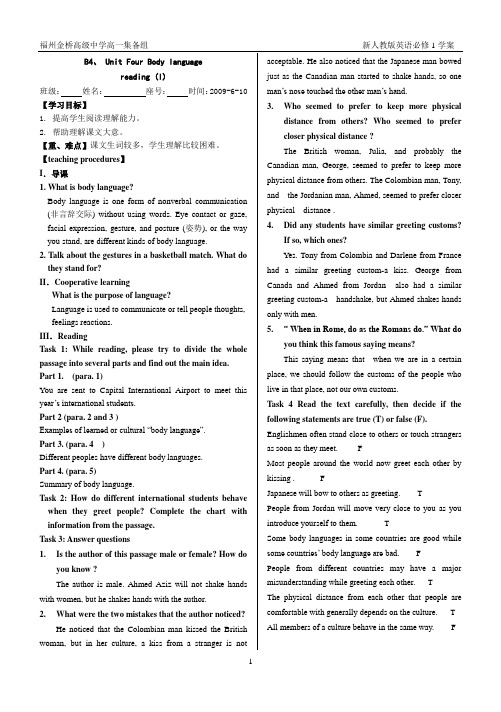
People from different countries may have a major misunderstanding while greeting each other.T
D. The importanceIf two men stand close to each other while talking, they cannot be from _____.
A. an Arab country B. USA
C. BritainD.Russia
B4、Unit Four Body language
reading (I)
班级:姓名:座号:时间:2009-6-10
【学习目标】
1.提高学生阅读理解能力。
2.帮助理解课文大意。
【重、难点】课文生词较多,学生理解比较困难。
【teaching procedures】
I.导课
1.What is body language?
2.What were the two mistakes that the author noticed?
He noticed that the Colombian man kissed the British woman, but in her culture, a kiss from a stranger is not acceptable. He also noticed that the Japanese man bowed just as the Canadian man started to shake hands, so one man’s nose touched the other man’s hand.
M4U4 body language Reading 阅读课学案
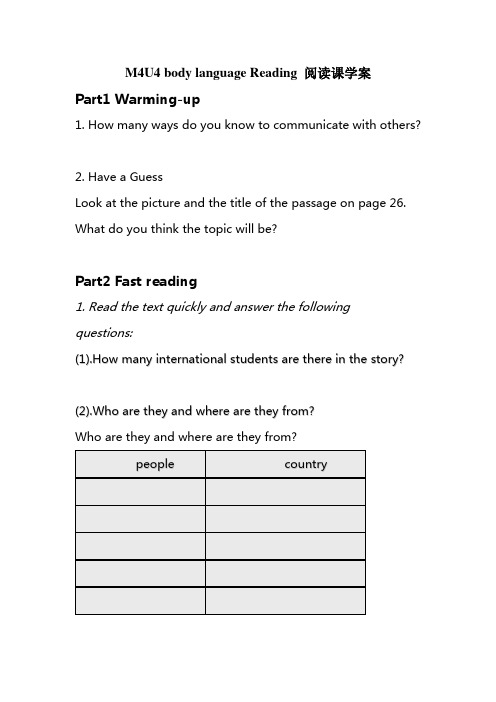
M4U4 body language Reading 阅读课学案Part1 Warming-up1. How many ways do you know to communicate with others?2. Have a GuessLook at the picture and the title of the passage on page 26. What do you think the topic will be?Part2 Fast reading1. Read the text quickly and answer the following questions:(1).H o w m a n y i n t e r n a t i o n a l s t u d e n t s a r e t h e r e i n t h e s t o r y?(2).W h o a r e t h e y a n d w h e r e a r e t h e y f r o m?Who are they and where are they from?p e o p l e c o u n t r y2.Divide the whole passage into four parts and match the main idea.Part 1 ___ B o d y l a n g u a g e v a r i e s f r o m c u l t u r e t oc u l t u r e,n o t a l l t h e s a m e.Part 2 ___ S u m m a r y o f b o d y l a n g u a g e.Part 3 ___ Y o u a r e s e n t t o A i r p o r t t o m e e t f o rf o r e ig n s t u d e n t s.Part 4 ___ E x a m p l e s o f c u l t u r a l“b o d y l a n g u a g e”.P a r t3Careful-Reading(1)1. Why were international students coming to China?2 . Who met international students at the Capital International Airport?3.What would be their arrangement (安排)after arriving school.(2)Find out the two cultural misunderstands in Para2Tony Garcia is from______The first mis-understandingJulia Smith is from________(3)True or false?1.Body language in some countries is good while some in others is bad.He approaches Ms Smith by _______ ______ _________ and _______ her on the ________.She ______ ________ appearing _________ and put up her hands as if_______ ______ . The secondmis-understandingAkira Nagata is from _________ George Cook is from_____ He ________ and his nose ________ George’s _______ ________. He ________ ________ _______ ________ to the Japanese student.2. All members of a culture behave in the same way.3. Learning English well can certainly help avoid difficulties in today’s world of cultural crossroads.(4)SummaryYesterday, another student and I,__________ our univers ity’s student__________, went to the Capital International Airport to meet this year’s international students to BeiJing University. After half an hour of waiting for their ____ to arrive, I saw several young people enter the waiting area looking around________.The first to arrive was Tony Garcia from Colombia,Tony_________ Julia, touched her shoulder and kissed her on the check! She stepped back as if in _______. I guessed there was probably a _____________ . In ______, studying international customs can certainly help avoid difficulties in today’s world of cultural_________.。
高中英语必修四Unit4BodyLanguageUsingLanguage学案
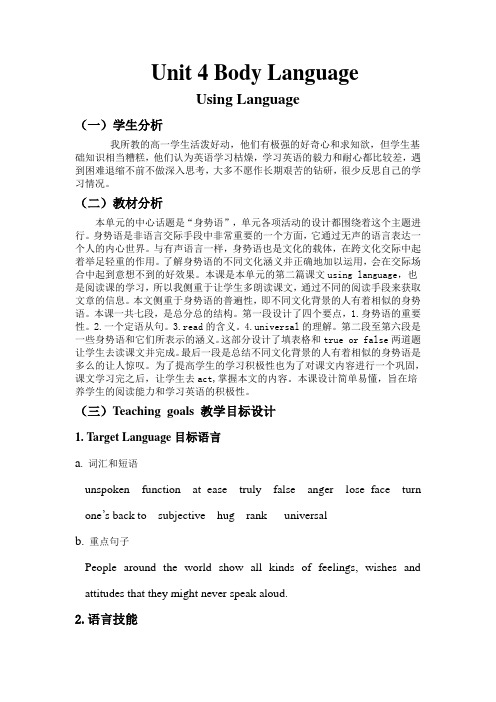
Unit 4 Body LanguageUsing Language(一)学生分析我所教的高一学生活泼好动,他们有极强的好奇心和求知欲,但学生基础知识相当糟糕,他们认为英语学习枯燥,学习英语的毅力和耐心都比较差,遇到困难退缩不前不做深入思考,大多不愿作长期艰苦的钻研,很少反思自己的学习情况。
(二)教材分析本单元的中心话题是“身势语”,单元各项活动的设计都围绕着这个主题进行。
身势语是非语言交际手段中非常重要的一个方面,它通过无声的语言表达一个人的内心世界。
与有声语言一样,身势语也是文化的载体,在跨文化交际中起着举足轻重的作用。
了解身势语的不同文化涵义并正确地加以运用,会在交际场合中起到意想不到的好效果。
本课是本单元的第二篇课文using language,也是阅读课的学习,所以我侧重于让学生多朗读课文,通过不同的阅读手段来获取文章的信息。
本文侧重于身势语的普遍性,即不同文化背景的人有着相似的身势语。
本课一共七段,是总分总的结构。
第一段设计了四个要点,1.身势语的重要性。
2.一个定语从句。
3.read的含义。
4.universal的理解。
第二段至第六段是一些身势语和它们所表示的涵义。
这部分设计了填表格和true or false两道题让学生去读课文并完成。
最后一段是总结不同文化背景的人有着相似的身势语是多么的让人惊叹。
为了提高学生的学习积极性也为了对课文内容进行一个巩固,课文学习完之后,让学生去act,掌握本文的内容。
本课设计简单易懂,旨在培养学生的阅读能力和学习英语的积极性。
(三)Teaching goals 教学目标设计1. Target Language目标语言a. 词汇和短语unspoken function at ease truly false anger lose face turn one’s back to subjective hug rank universalb.重点句子People around the world show all kinds of feelings, wishes and attitudes that they might never speak aloud.2.语言技能能理解课文内容和课文结构,在阅读中运用scanning, careful reading等技能,能得体的表达个人的思想观点,将现学知识与原有知识结合,恰当地表达对身势语的认识。
高中英语Unit4 Body Language Reading阅读导学案新人教版必修4
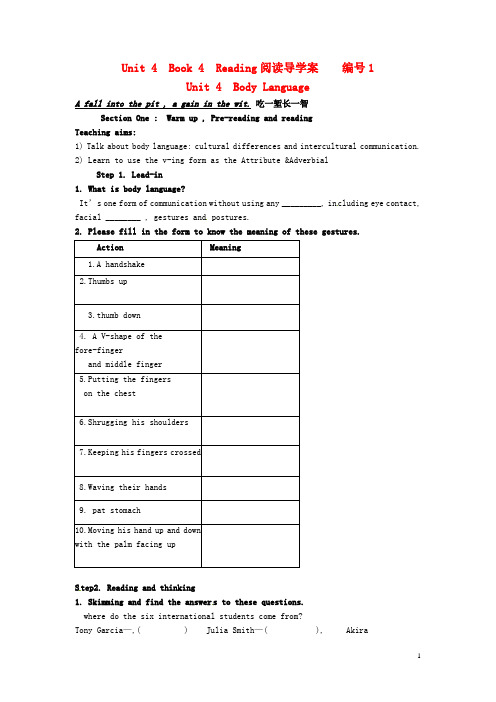
Unit 4 Book 4 Reading阅读导学案编号1Unit 4 Body LanguageA fall into the pit , a gain in the wit. 吃一堑长一智Section One : Warm up , Pre-reading and readingTeaching aims:1) Talk about body language: cultural differences and intercultural communication.2) Learn to use the v-ing form as the Attribute &AdverbialStep 1. Lead-in1. What is body language?It’s one form of communication without usin g any _________, in cluding eye contact, facial ________ , gestures and postures.2. Please fill in the form to know the meaning of these gestures.S tep2. Reading and thinking1. Skimming and find the answer s to these questions.where do the six international students come from?Tony Garcia—,( ) Julia Smith—( ), AkiraNagata—( ), Geor ge Cook—( ), AhmedAziz—( ), Darlene Coulon—( )2. Read the passage carefully, choose the best answers.1). Why did the writer go to the airport yesterday?A. To see off his friend.B. To meet international students.C. To buy a flight ticket.D. To meet some visitors coming from several countries.2). The first person arriving at the airport is ___.A. Darlene CoulonB. Tony GarciaC. George CookD. Ahemed Aziz3). What do Japanese do when meeting others?A. Bow.B. Shake hands.C. Only smile.D. Touch others’ shoulders.4). According to the text, ____ do not usually stand very closeto others or touch strangers as soon as they meet.A. JapaneseB. men from Middle Eastern countriesC. FrenchmenD. English people5). According to the text, men from Middle Eastern often ____.A. nod heads and wave hands to girlsB. touch other s’ heads when they first meetC. kiss each other twice on each cheekD. stand quite close to other men when they talk3. Read the passage carefully and tell T/F.1. The first cultural mistake referred to in the text was a misunderstanding betweenan. English and a Japanese. ( )2. Frenchmen like to kiss each other when they meet peoplethey know. ( )3. Canadians like to shake hands when they are first introduced. ( )4. If you meet a person from Jordan, you should kiss him onthe cheek and touch him. ( )5. Besides spoken language, people can communicate witheach other through physical distance, actions or posture. ( )Step3. Discussion1.Choose the right main idea of each part.1. Part 1 (Para. ___) _________ Part 2 (Para. ___) _________Part 3 (Para. ___) _________ Part 4 (Para. ___) _________A. Examples of learned or cultural “body language”.B. You are sent to CIA to meet this year’s international students.C. Summary of body language.D. Different people has different body language.2 The main idea of the whole text:It tells us about the ___________ and _________of body language and its __________ between different cultures.3.What do people in different countries do when meeting?China, Britain: ___________Russ ia, France, Arab:___________Some western countries: ___________Japan: ___________Step 4. TestingFill in the blanks using the words from the text on Page 26Yesterday, another student and I,1. _________ our university's student 2. ,went to the Capital International Airport to meet this year's international students to Beijing Uni versity. After half an hour of waiting for th eir 3. to arrive, I saw several young people enter the waiting area looking around 4. The first person to arr ive was Tony Garcia from Colombia. Tony 5. Julia, touched her shoulder and kissed her on the cheek! S he stepped back as if in 6. . I guessed there was probably a 7. .When I met Ahmed Aziz from Jordan, he moved very 8 to me as I 9. myself. Darlene from France came 10. through the door and shook hands with Tony.Flowers will bloom again in due time, but man can never regain his youth. 花有重开日,人无再少年。
高中英语人教版必修4Unit4BodylanguageReading教案(系列一)
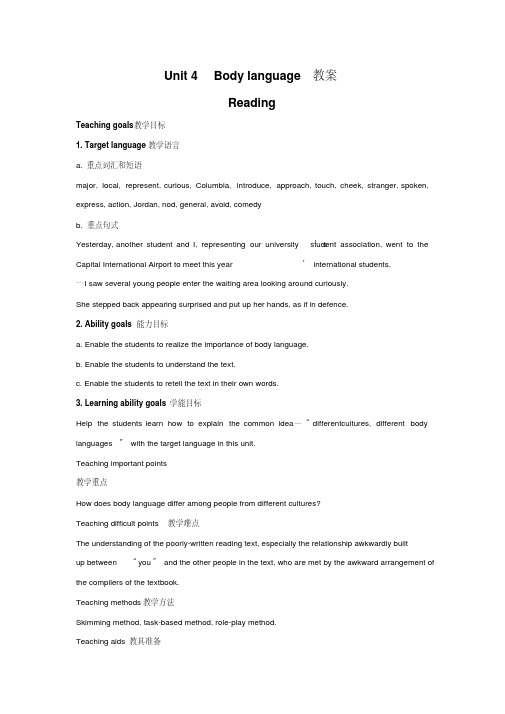
Unit 4 Body language 教案ReadingTeaching goals教学目标1. Target language教学语言a. 重点词汇和短语major, local, represent, curious, Columbia, introduce, approach, touch, cheek, stranger, spoken, express, action, Jordan, nod, general, avoid, comedyb. 重点句式student association, went to the Yesterday, another student and I, representing our university’sCapital International Airport to meet this year’ international students.…I saw several young people enter the waiting area looking around curiously.She stepped back appearing surprised and put up her hands, as if in defence.2. Ability goals 能力目标a. Enable the students to realize the importance of body language.b. Enable the students to understand the text.c. Enable the students to retell the text in their own words.3. Learning ability goals学能目标Help the students learn how to explain the common idea—“different c ultures, different body languages” with the target language in this unit.Teaching important points教学重点How does body language differ among people from different cultures?Teaching difficult points 教学难点The understanding of the poorly-written reading text, especially the relationship awkwardly builtup between “you” and the other people in the text, who are met by the awkward arrangement of the compilers of the textbook.Teaching methods教学方法Skimming method, task-based method, role-play method.Teaching aids 教具准备。
高中英语人教必修4 unit 4 body language reading教学设计
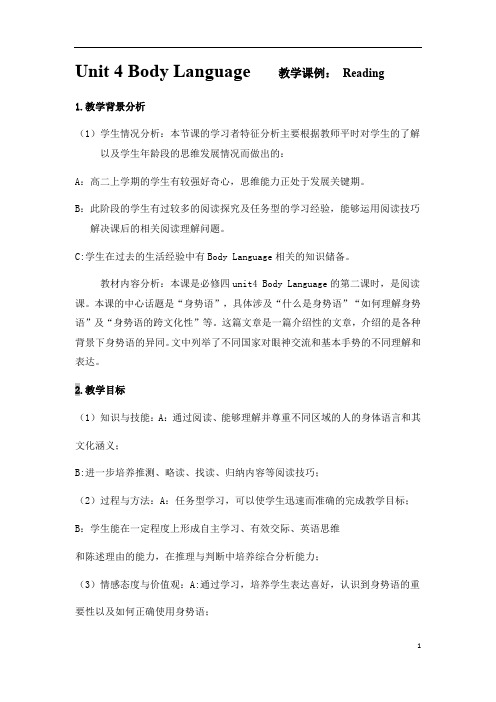
Unit 4 Body Language 教学课例:Reading1.教学背景分析(1)学生情况分析:本节课的学习者特征分析主要根据教师平时对学生的了解以及学生年龄段的思维发展情况而做出的:A:高二上学期的学生有较强好奇心,思维能力正处于发展关键期。
B:此阶段的学生有过较多的阅读探究及任务型的学习经验,能够运用阅读技巧解决课后的相关阅读理解问题。
C:学生在过去的生活经验中有Body Language相关的知识储备。
教材内容分析:本课是必修四unit4 Body Language的第二课时,是阅读课。
本课的中心话题是“身势语”,具体涉及“什么是身势语”“如何理解身势语”及“身势语的跨文化性”等。
这篇文章是一篇介绍性的文章,介绍的是各种背景下身势语的异同。
文中列举了不同国家对眼神交流和基本手势的不同理解和表达。
2.教学目标(1)知识与技能:A:通过阅读、能够理解并尊重不同区域的人的身体语言和其文化涵义;B:进一步培养推测、略读、找读、归纳内容等阅读技巧;(2)过程与方法:A:任务型学习,可以使学生迅速而准确的完成教学目标;B:学生能在一定程度上形成自主学习、有效交际、英语思维和陈述理由的能力,在推理与判断中培养综合分析能力;(3)情感态度与价值观:A:通过学习,培养学生表达喜好,认识到身势语的重要性以及如何正确使用身势语;B:感受文化差异,学生尊重与包容;3.教学重点(1)帮助学生通过身势语的不同了解文化之间的差异;(2)通过各种阅读方法了解文章的主旨大意以及细节内容;(3)通过阅读让学生熟悉各种不同的阅读方法并且掌握本单元的相关词汇;4.教学难点(1)学生对于不同阅读方法的掌握,如何在阅读中将听说写结合起来;(2)如何培养学生自主学习能力,例如小组讨论等;(3)如何让学生感知文化差异;9.教学过程设计(1)总体设计:本节是导入及阅读课,教学重点是培养学生的阅读策略和技巧,同时培养学生对不同文化的兴趣。
Unit4Bodylanguage-Reading学案(新人教版必修4)
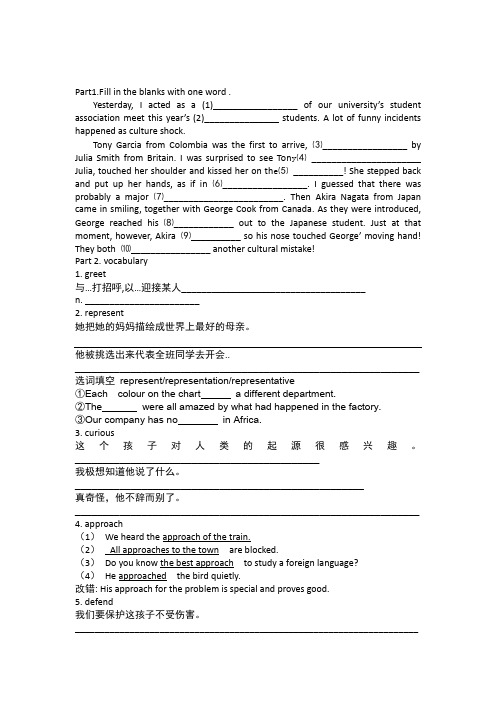
Part1.Fill in the blanks with one word .Yesterday, I acted as a (1)_________________ of our university’s student association meet this year’s (2)_______________ students. A lot of funny incidents happened as culture shock.Tony Garcia from Colombia was the first to arrive,⑶_________________ by Julia Smith from Britain. I was surprised to see Ton y⑷______________________ Julia, touched her shoulder and kissed her on th e⑸__________! She stepped back and put up her hands, as if in⑹_________________. I guessed that there was probably a major⑺________________________. Then Akira Nagata from Japan came in smiling, together with George Cook from Canada. As they were introduced, George reached his⑻____________ out to the Japanese student. Just at that moment, however, Akira⑼__________ so his nose touched George’ moving hand! They both⑽________________ another cultural mistake!Part 2. vocabulary1. greet与…打招呼,以…迎接某人_____________________________________n. _______________________2. represent她把她的妈妈描绘成世界上最好的母亲。
必修4Unit 4 Body language学案 (1)
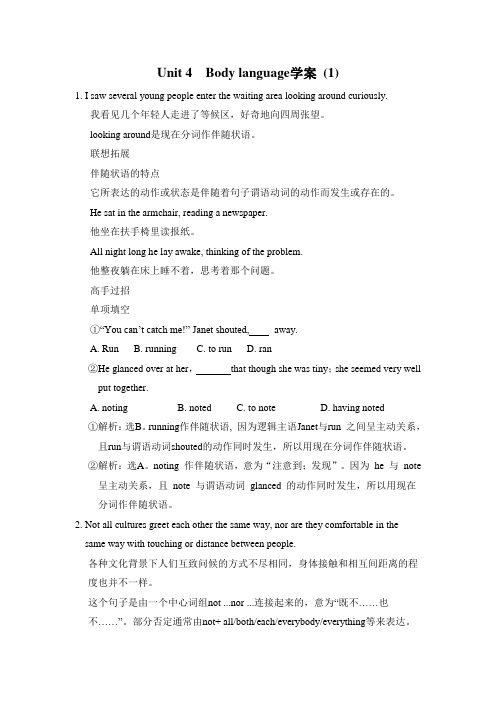
Unit 4Body language学案(1)1. I saw several young people enter the waiting area looking around curiously.我看见几个年轻人走进了等候区,好奇地向四周张望。
looking around是现在分词作伴随状语。
联想拓展伴随状语的特点它所表达的动作或状态是伴随着句子谓语动词的动作而发生或存在的。
He sat in the armchair, reading a newspaper.他坐在扶手椅里读报纸。
All night long he lay awake, thinking of the problem.他整夜躺在床上睡不着,思考着那个问题。
高手过招单项填空①“You can’t catch me!” Janet shouted,away.A. RunB. runningC. to runD. ran②He glanced over at her,that though she was tiny;she seemed very wellput together.A. notingB. notedC. to noteD. having noted①解析:选B。
running作伴随状语, 因为逻辑主语Janet与run 之间呈主动关系,且run与谓语动词shouted的动作同时发生,所以用现在分词作伴随状语。
②解析:选A。
noting 作伴随状语,意为“注意到;发现”。
因为he 与note呈主动关系,且note 与谓语动词glanced 的动作同时发生,所以用现在分词作伴随状语。
2. Not all cultures greet each other the same way, nor are they comfortable in the same way with touching or distance between people.各种文化背景下人们互致问候的方式不尽相同,身体接触和相互间距离的程度也并不一样。
Unit4BodyLanguageReadingandThinking学案高中英语人教版选择性
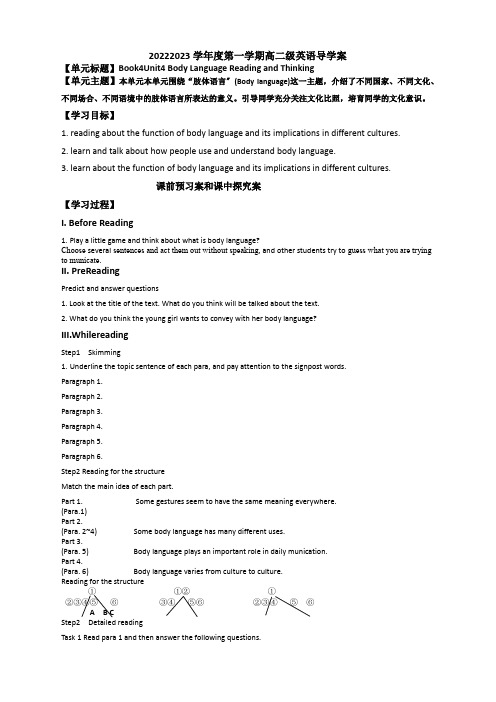
20222023学年度第一学期高二级英语导学案【单元标题】Book4Unit4 Body Language Reading and Thinking【单元主题】本单元本单元围绕“肢体语言〞(Body language)这一主题,介绍了不同国家、不同文化、不同场合、不同语境中的肢体语言所表达的意义。
引导同学充分关注文化比照,培育同学的文化意识。
【学习目标】1. reading about the function of body language and its implications in different cultures.2. learn and talk about how people use and understand body language.3. learn about the function of body language and its implications in different cultures.课前预习案和课中探究案【学习过程】I. Before Reading1.Play a little game and think about what is body language?Choose several sentences and act them out without speaking, and other students try to guess what you are trying to municate.II. PreReadingPredict and answer questions1. Look at the title of the text. What do you think will be talked about the text.2. What do you think the young girl wants to convey with her body language?III.WhilereadingStep1 Skimming1.Underline the topic sentence of each para, and pay attention to the signpost words.Paragraph 1.Paragraph 2.Paragraph 3.Paragraph 4.Paragraph 5.Paragraph 6.Step2 Reading for the structureMatch the main idea of each part.Part 1. Some gestures seem to have the same meaning everywhere.(Para.1)Part 2.(Para. 2~4) Some body language has many different uses.Part 3.(Para. 5) Body language plays an important role in daily munication.Part 4.(Para. 6) Body language varies from culture to culture.Reading for the structure①①②①②③④⑤⑥③④⑤⑥②③④⑤⑥A B CStep2 Detailed readingTask 1 Read para 1 and then answer the following questions.1. What does the word “interaction 〞 in the first sentence in Paragraph 1 means? A. exchange B. relationship C. munication D. reaction2. What is the function of the last sentence in Paragraph 1? Task 2 Read Para. 23 and fill in the chart.1. Shake one’s head means “no 〞and nodding means “yes 〞 in Bulgaria and some southern Albania.T() F( )2. What do people in France and Russia usually do when they meet someone else? A. They employ the “OK 〞 gesture. B. They make eye contact.C. They kiss their friends on the cheek.D. They shake their hands and nod their heads. Task 3 Read para 6 and answer the question.What different uses of smiling are mentioned in Para 6? Find out the varied sentence structures used to show uses of smiling.IV. PostreadingTask1 watch the video Smile Trial , and discuss the following questions.1. After watching the video, do you know how to distinguish which smile is fake?2. Apart from fake smiles, is there any other kind of body language that can sometimes be fake? Task 2 Small Talk3. What advice on body language can you give a foreign friend on his/her first trip on China? Please work in pairs to discuss.Tip: you can discuss from following aspects(what he/she can do & what he/she can ’t do): 1.How people greet? 2.How talking with people? 3.How sitting/standing? ... ... Advice on body language in China1. In China,when people meet, it is proper for us to , rather than , and.Eye contact2. In China, it’s good manners to and have when talking to others.3. In China,when we sit or stand, we ’d better not or .V. SummaryWhat have we learned in this class?VI. HomeworkTask 1 Write an advice letter to Nick on body language interaction on his first trip to China. Task 2 Fill in the blanks according to the text.We use both words and body language __________(express) our thoughts and opinions in our ____________(interact) with other people. Just like spoken language, body language _________(vary) from culture to culture. The crucial thing is _________(use) body language in a way that is appropriate to the culture you are in. For example, _______ (make) eye contact is not appropriate to all cultures. Some gestures like the one for “OK’ have different meanings in different cultures. Even the gestures we use for “yes 〞and “no 〞differ around the world. There are also differences ______ how we touch each other, how close we stand _____ someone we are talking to, and how we act when we meet or part. Such gestures _____ the ones for “sleep 〞and “I am full 〞 seem to have _____ same meaning everywhere.Some body language has many different uses. One example is smiling.【自我评价〔selfevaluation 】Think about this passage learning and plete the following form. Rate yourself on a scale of five: one being low andfive being high, andput it into yourportfolio.。
